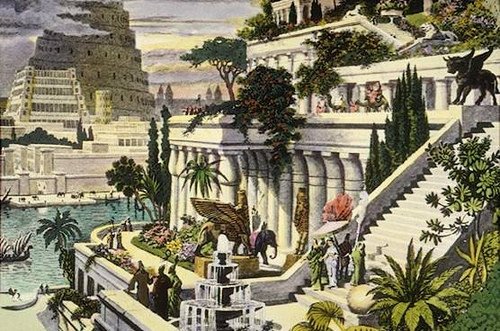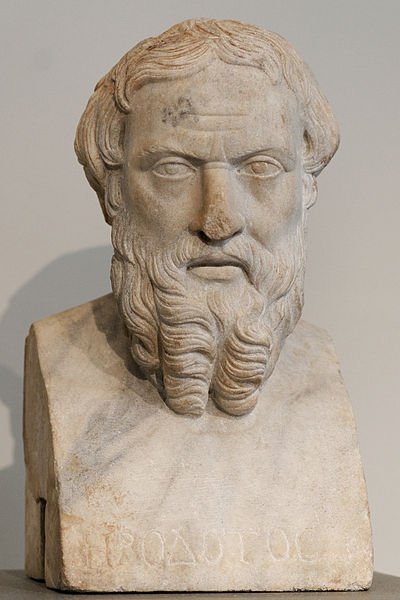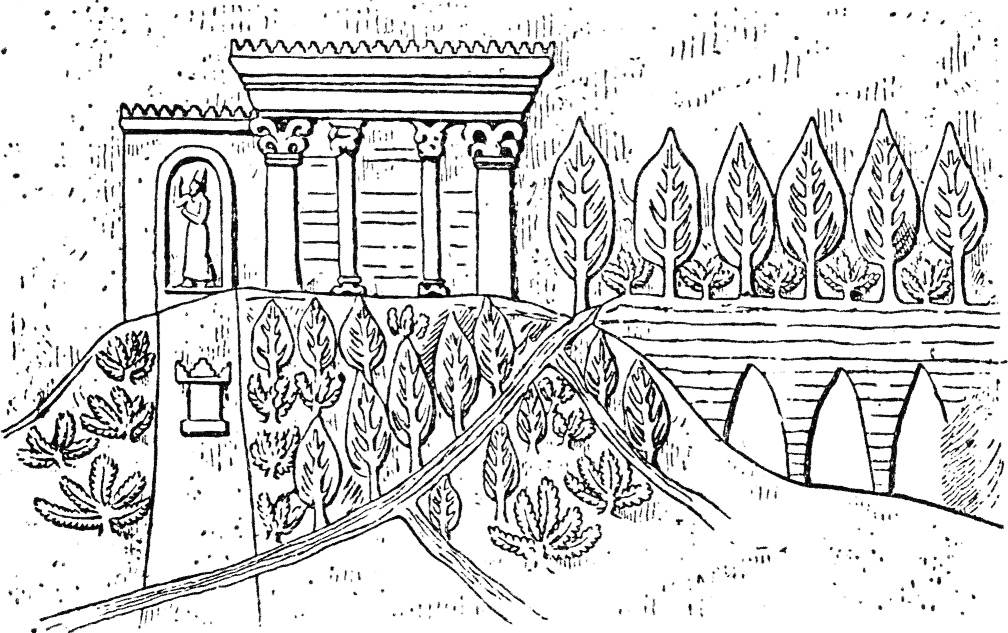
a hand coloured engraving, depicting the fabled hanging gardens
Image source
The Hanging Gardens of Babylon evoke a romantic picture of dense greenery and colorful flowers teeming with life cascading from the sky. The grandeur of their sight must have been awe-inspiring, the magnificence, what a sight to behold. Oh! If only it lived down to our time.
Little wonder the ancient World would have considered them one of the
Seven Wonders of the Ancient World.
However, strange as it seems one of the city's most spectacular sites was not mentioned by Herodotus.
Herodotus (/hɪˈrɒdətəs/ ; Ancient Greek :
Ἡρόδοτος, Hêródotos , Attic Greek pronunciation: [hɛː.ró.do.tos] ) was a Greek historian who was born in Halicarnassus in the
Persian Empire (modern-day Bodrum , Turkey ) and lived in the fifth century BC (c. 484–c. 425 BC), a contemporary of Thucydides, Socrates, and Euripides.
He is often referred to as "The Father of History", a title first conferred by Cicero; he was the first historian known to have broken from Homeric tradition to treat historical subjects as a method of investigation—specifically, by collecting his materials systematically and critically, and then arranging them into a historiographic narrative.

Herodotus
image source
Where the gardens really hanging as the name ascribes?
The Hanging Gardens probably did not really "hang" in the sense of being suspended from cables or ropes. The name comes from an inexact translation of the Greek word "kremastos", or the Latin word "pensilis", which means not just "hanging", but "overhanging" as in the case of a terrace or balcony.
What exactly are hanging gardens?. According to the Wikipedia;
Hanging garden (cultivation), a sustainable landscape architecture, an artistic garden or a small urban farm, attached to or built on a wall.
Gift for a Home Sick Queen
According to one legend, Nebuchadnezzar II who ruled the city for some 43 years starting from 605 BC, built the Hanging Gardens for his Median wife, Queen Amytis.
Amytis, daughter of the king of Medes had married Nebuchadnezzar in a bid to further the alliance between the two nations.
Amytis was homesick for the land she came from, green and mountainous and found the flat and arid terrain of Babylon depressing. In an effort to cheer her up an elaborate garden; an artificial mountain with rooftop gardens were constructed to mimic the ones in her homeland.
MYTH, LEGEND OR FACT
Traditionally, the gardens were said to have been built in the ancient city of Babylon, near present-day Hillah, Babil province, in Iraq. The Babylonian priest Berossus, in his writings around 290 BC, which was later quoted by Josephus, attributed the gardens to a Babylonian King Nebuchadnezzar II, who ruled between 605 and 562 BC.
The location of the complex contradicts where Greek historians placed the Gardens, which was on the banks of the River Euphrates.
Notably also and not to be overlooked is the fact that most of the ancient writing were made by Greek historians and most made mention of a Syrian king apart from Josephus.
Josephus (c.37–100 AD)
Diodorus Siculus (active c.60–30 BC)
Quintus Curtius Rufus (fl. 1st century AD)
Strabo (c.64 BC – 21 AD)
Philo of Byzantium (4th–5th century AD)
Because of the lack of documentation of them in the chronicles of Babylonian history, many doubt they were ever there.
Stephanie Dalley, an Oxford University Assyriologist, thinks that those ancient sources were translated incorrectly putting the hanging gardens about 350 miles south of their actual location at Nineveh. King Sennacherib left a number of records describing a luxurious set of gardens he'd built in conjunction with an extensive irrigation system. In contrast Nebuchadnezzar made no mention of gardens as one of his accomplishments at Babylon. Dalley also argues that the name "Babylon" which means "Gate of the Gods" was a title that could be applied to several Mesopotamian cities. Sennacherib obviously renamed his city gates after gods suggesting that he wished Nineveh to be considered "a Babylon" too, creating some confusion.
Recent discoveries includes evidence of excavation of a vast system of aqueducts inscribed to Sennacherib, which Dalley proposes were part of a 80-kilometre (50 mi) series of canals, dams, and aqueducts used to carry water to Nineveh with water-raising screws, to raise water to the upper levels of the gardens.

This copy of a bas relief from the North Palace of Ashurbanipal (669–631 BC) at Nineveh shows a luxurious garden watered by an aqueduct.
True, some believe that the Hanging Gardens never came into existence, however, it is not outside of the scope of possibility that they were real. The technology of the time would have allowed for their construction. This, however, does not explain the lack of definitive documentation. Why then would later historians spend so much time and effort describing this masterpiece of ancient history if it did not exist in some physical form atleast?
If they did exist, what happened to the gardens? There is a report that they were destroyed by an earthquake in the second century B.C.. If so, the remains, mostly made of mud-brick, might have slowly weared away with the infrequent rains.
Whatever the fate of the gardens were, we can only wonder if Queen Amyitis was happy with her fantastic present, or if she continued to long for the green mountains of her distant homeland.
In my own words, "Art Lost in Time ".
For further reading, check out the references.
Ref 1
Ref 2
Ref 3
Thanks For Reading. If You Liked it
Please UPVOTE and RESTEEM
And I used to have the thinking back then that the gardens were suspended
Lol, it doesn't really hang in a literal sense. But from the broad aspect of its definition it does, cause the plants are attached to the walls according to the wikipedia definition. Although a typical hanging garden, cascades in the real sense. You could search for pictures in google with the keyword "hanging garden"
Congratulations! This post has been upvoted from the communal account, @minnowsupport, by bco from the Minnow Support Project. It's a witness project run by aggroed, ausbitbank, teamsteem, theprophet0, someguy123, neoxian, followbtcnews, and netuoso. The goal is to help Steemit grow by supporting Minnows. Please find us at the Peace, Abundance, and Liberty Network (PALnet) Discord Channel. It's a completely public and open space to all members of the Steemit community who voluntarily choose to be there.
If you would like to delegate to the Minnow Support Project you can do so by clicking on the following links: 50SP, 100SP, 250SP, 500SP, 1000SP, 5000SP.
Be sure to leave at least 50SP undelegated on your account.
Nice
@originalworks
@steem-untalented
This is very educative. Never ever knew such a garden existed. Perhaps someday I will visit the place and see for myself.
Yeah, someday...
Well done..nice work u have done here..
Thanks man, glad you appreciate...
awesome write up. I now know much!
Lol, sure. The name is actually misleading in a sense... Happy to know you learnt something.